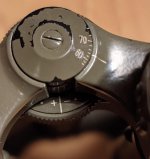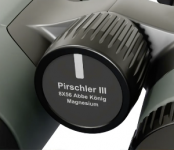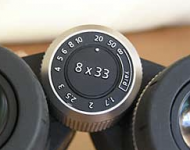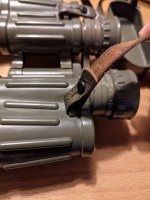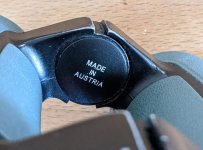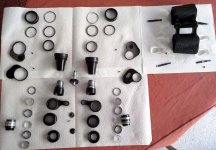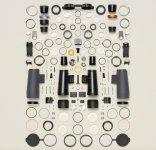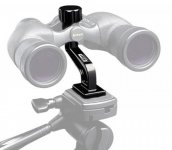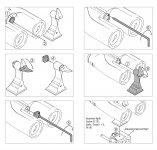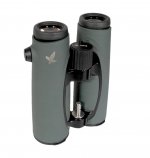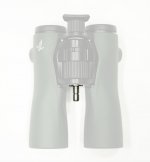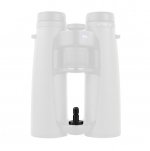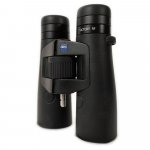The other day I was using a classic binocular (a 7x42 Swarovski Habicht) when I realised (once again) how old designs sometimes have great lessons to teach. In this case, about inexpensive improvements to the everyday usability of binoculars.
Contemporary binoculars are usually preferred for the “overall package” they offer, and for good reason! They may not have the build quality of many classics, nor are they designed to withstand the pass of time or severe field use, but for a reasonable 200 - 500 $/€ (even less in some cases) you can have very good optical performance (that surpasses in some areas classical devices) and you can enjoy things like waterproofness, comfortable twist-up eyecups with multiple positions, a comfy and resistant rubber armour and a nice neoprene strap that makes hauling your gear an easy chore, together with tethered objective covers if you like that sort of thing.
But then, when you use classic binoculars you sometimes find simple, even innocent, elements that make the everyday use very pleasurable. I’ll name a few, but I’m sure other forum members with more experience will be able to recognise more.
- IPD index. This is such a silly thing, but so useful. Easy to find in Porro prism binoculars. Essential if you usually use your binoculars together with other people or like to share them. But even if you don’t, a quick glance reassures you that the IPD is correct before putting them to your eyes. My IPD is around 68 mm (depending on binocular and watching distance, but 68 usually does the trick), my partner's IPD is 60. Knowing this and having a little index makes exchanging binoculars a breeze.
- Focus distance index. I know some current binoculars have something like this, namely the HG series by Minox (an indication of distance from close to infinity in the focus wheel, picture from birdwatching.com) or the DDOptics Pirschler Gen 3, that has a mark (both in bright colour and tactile mark, see picture) when the focus is at 50 m, which will make it sharp to infinity. I wonder if the little vertical mark on the focus wheel of the Swarovski EL serves the same purpose. On my 8x32 I’d say it’s set to a bit beyond 50 m. Anyway, this is something you don’t see that often and is a simple and easy way to prepare your focus wheel even before you lift it.
If you look at the first picture attached you can see both of these simple features on a classic design (Swarovski Habicht): IPD Index and focus distance index.
- Easy strap attachment. Again, maybe not relevant for everybody, especially if you don’t usually take take your strap off your binoculars. In my case, this is something I do almost everyday. I find the strap is annoying and gets in the middle when I’m at home looking from my window, or at night watching the stars, or many times taking a walk when I don’t want the binoculars hanging and simply put them in my pocket (or the case I wear on my belt). The buckles or quick release system of a harness help with this, but I just don't feel like wearing a harness very often (especially for something like a 8x30 or 8x32). So I find myself in the tedious process of doing and undoing the strap attaching thingy very often. Some old models have this simple button system, like the Leica Trinovid BA/BN or the Habicht (see picture) that takes 1 second to do and undo. Whenever I use those models wonder why can't all binoculars be like that. Naturally, this system usually implies there’s no way to shorten or lengthen the strap, but Swarovski came around this with the LCS strap, that shares this simple and fast button attachment system with an easy and fast way to shorten/lengthen the strap (the Field Pro system also does this, although it uses a proprietary connector to attach it only to FP models; I just find it over-engineered in a complicated way for something a lug does jus perfectly).
These are things that in many cases could be very easily incorporated to new models. For example, in open hinge binoculars, the IPD index could be easily printed on the rear side of the front hinge (see last picture).
What other features from classical/old binoculars do you miss in contemporary ones? (I wish binocular designers are reading this )
)
Contemporary binoculars are usually preferred for the “overall package” they offer, and for good reason! They may not have the build quality of many classics, nor are they designed to withstand the pass of time or severe field use, but for a reasonable 200 - 500 $/€ (even less in some cases) you can have very good optical performance (that surpasses in some areas classical devices) and you can enjoy things like waterproofness, comfortable twist-up eyecups with multiple positions, a comfy and resistant rubber armour and a nice neoprene strap that makes hauling your gear an easy chore, together with tethered objective covers if you like that sort of thing.
But then, when you use classic binoculars you sometimes find simple, even innocent, elements that make the everyday use very pleasurable. I’ll name a few, but I’m sure other forum members with more experience will be able to recognise more.
- IPD index. This is such a silly thing, but so useful. Easy to find in Porro prism binoculars. Essential if you usually use your binoculars together with other people or like to share them. But even if you don’t, a quick glance reassures you that the IPD is correct before putting them to your eyes. My IPD is around 68 mm (depending on binocular and watching distance, but 68 usually does the trick), my partner's IPD is 60. Knowing this and having a little index makes exchanging binoculars a breeze.
- Focus distance index. I know some current binoculars have something like this, namely the HG series by Minox (an indication of distance from close to infinity in the focus wheel, picture from birdwatching.com) or the DDOptics Pirschler Gen 3, that has a mark (both in bright colour and tactile mark, see picture) when the focus is at 50 m, which will make it sharp to infinity. I wonder if the little vertical mark on the focus wheel of the Swarovski EL serves the same purpose. On my 8x32 I’d say it’s set to a bit beyond 50 m. Anyway, this is something you don’t see that often and is a simple and easy way to prepare your focus wheel even before you lift it.
If you look at the first picture attached you can see both of these simple features on a classic design (Swarovski Habicht): IPD Index and focus distance index.
- Easy strap attachment. Again, maybe not relevant for everybody, especially if you don’t usually take take your strap off your binoculars. In my case, this is something I do almost everyday. I find the strap is annoying and gets in the middle when I’m at home looking from my window, or at night watching the stars, or many times taking a walk when I don’t want the binoculars hanging and simply put them in my pocket (or the case I wear on my belt). The buckles or quick release system of a harness help with this, but I just don't feel like wearing a harness very often (especially for something like a 8x30 or 8x32). So I find myself in the tedious process of doing and undoing the strap attaching thingy very often. Some old models have this simple button system, like the Leica Trinovid BA/BN or the Habicht (see picture) that takes 1 second to do and undo. Whenever I use those models wonder why can't all binoculars be like that. Naturally, this system usually implies there’s no way to shorten or lengthen the strap, but Swarovski came around this with the LCS strap, that shares this simple and fast button attachment system with an easy and fast way to shorten/lengthen the strap (the Field Pro system also does this, although it uses a proprietary connector to attach it only to FP models; I just find it over-engineered in a complicated way for something a lug does jus perfectly).
These are things that in many cases could be very easily incorporated to new models. For example, in open hinge binoculars, the IPD index could be easily printed on the rear side of the front hinge (see last picture).
What other features from classical/old binoculars do you miss in contemporary ones? (I wish binocular designers are reading this
Attachments
Last edited:




